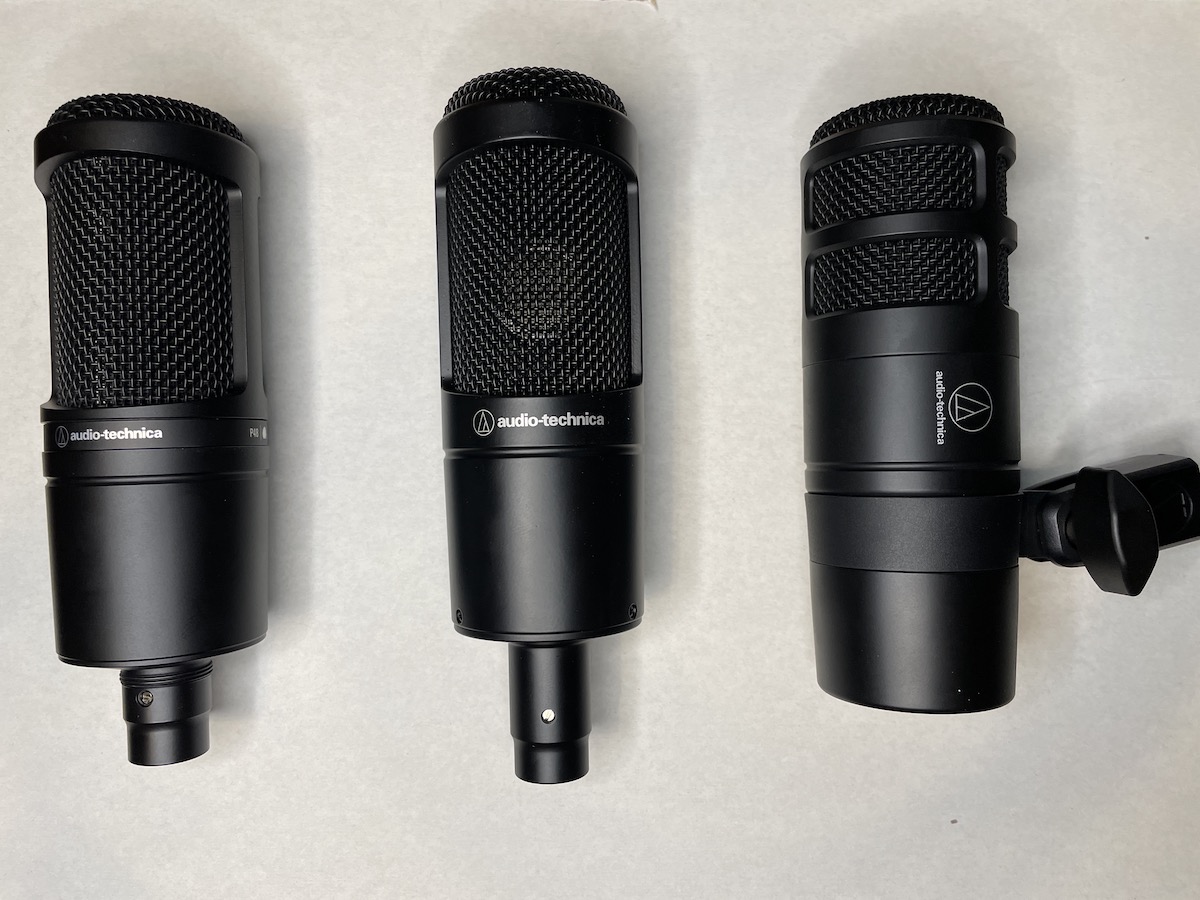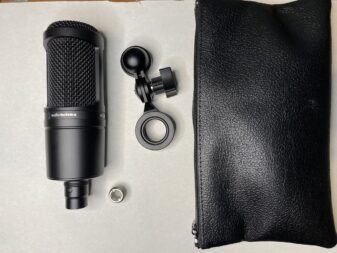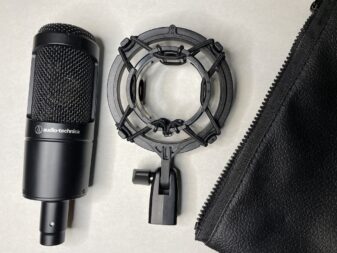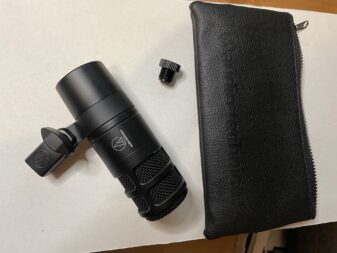
Today I have an Audio-Technica microphone review and comparison to share. It is a unique opportunity for us to explore and compare three microphone models from Audio-Technica at the same time. The three models are the AT2020, the AT2035, and the AT2040. In my review, I will detail each microphone’s intended purpose, and each package’s contents, and offer my opinion on the quality of each microphone.
Audio-Technica AT2020: a condenser mic for home studios
First on my list is the AT2020. This condenser microphone is designed for project studios and home studios. It features a cardioid polar pickup pattern which reduces sounds from both the sides and the rear. The cardioid polar pattern is useful for isolating voices in environments with some background noise. It is also useful for recording individual instruments such as the guitar. The 16mm low-mass diaphragm has a full frequency response from 20Hz to 20KHz.
Because the AT2020 is a condenser microphone, you will need to use an interface or sound console that features +48V phantom power. Luckily, this is a standard feature on almost every audio interface or sound console available in stores or online.
Included accessories are essential to work with

In the box, we find the AT2020 alongside included accessories. Accessories include the AT8466 stand mount for 5/8” threaded stands, a 5/8” to 3/16″ adapter, and finally, a simple carrying pouch to carry and protect the microphone. The stand mount is nice, it provides many different choices for microphone placement.
I was curious to see how well the cardioid polar pattern rejects sound from the sides and rear. When we record vocals, narration, or an instrument, we often want a direct source recording.
I am happy to report that the AT2020 does a fantastic job to cut out the excess surrounding sounds. In my estimation, the sides and rear of the microphone reject about 50%, perhaps more, of the sound. So long as you are speaking directly into the microphone, you should have no major issues with outside sound bleeding through.
The AT2020 sounds solid. When considering the price point of the model, there is no reason to complain. It has a full sonic response. I can hear a nice bass tone from my voice along with sibilant details as I pronounce my “t” and “s” sounds. I think with proper audio EQ and compression during the production process you will get very good results.
When I use it with my acoustic guitar, it responds well. I am not convinced it is the best option for recording acoustic guitar. However, if it were your only microphone you could make good use of the AT2020.
Audio-Technica AT2035: a cardioid condensor microphone that sounds great
Full disclosure on this one, I have owned an AT2035 for a few years now. I know it well. The microphone comes with a shock mount that fits a regular microphone stand and a carrying case.

The AT2035 is another condenser-type microphone. At first glance, it looks quite similar to the AT2020. However, the AT2035 is a very different microphone. The mic design features a cardioid pattern, not to be confused with the AT2020’s cardioid polar pattern.
The AT2035 will capture sound from all around the diaphragm. Yes, it rejects a little bit from the sides, but not very much. As a result, the use of the AT2035 is more versatile. The cardioid pattern makes it a great choice for recording acoustic instruments of all sorts. You might also use it to record room sounds, as the diaphragm captures sound from the front and back.
But the AT2035 offers more than its cardioid pattern. It is also a large-diaphragm mic, which gives us a better and more dynamic frequency response. It also responds well to soft and loud sound pressure levels (SPL). You could whisper or speak loudly into the microphone, and it will capture the sound well.
The large diaphragm also responds well to lower frequencies. I have used this model for recording my acoustic stand-up bass with great results. It also sounds great on other instruments such as trombones or trumpets.
Overall, the AT2035 is a great microphone. It is robust, it sounds great and it has the extra features to help you in a variety of situations. I would recommend it to musicians, podcasters, content creators, and streamers alike!
Low Cut and -10dB Pad switches are very useful tools
Two additional reasons the AT2035 works so well for many applications are the 80Hz Low Cut switch and the -10dB pad. These two little white switches, easy to find on the back side of the microphone, make the microphone very adaptable.
The 80Hz low cut helps to reduce undesirable noise from passing traffic, air ventilation systems, and the sound of the room in general. Most sound engineers would roll off almost all frequencies below 80Hz in post-production as a standard procedure. Luckily, the AT2035 can do it for you in advance.
The -10dB pad is useful for loud sound sources. A particularly robust vocal performance or a blast from an instrument such as a loud trumpet can easily overload the microphone. Through the use of the -10dB pad, you instantly reduce the microphone’s output by 10 decibels. This will help to set the correct gain level and therefore your recording session will flow much easier.
I used the AT2035 with my acoustic guitar, and I am very pleased with the result. For my ears, engaging the Low Cut switch really helped turn my guitar sound from muddy and bass-laden into something solid and pleasing for my recordings.
Audio-Technica AT2040: a fantastic broadcast dynamic microphone
The third microphone is the AT2040. Compared to the AT2020 and AT2035, this is a very different microphone! The AT2040 is a hypercardioid dynamic microphone, unlike the condenser AT2020 and ATR2035. As a result, it offers excellent noise rejection and professional broadcast-quality sound. The AT2040 is designed for narration and features a non-woven filter to help reduce pops and clicks while you are talking.

Based on Audio-Technica’s BP40 broadcast microphone, the AT2040 has a sturdy build quality, weighing approximately 600g. It is noticeably heavier than the other two microphones.
It features an integrated microphone clip, which fits on a regular microphone stand or a tripod stand, using the included adapter.
After I plug in the microphone and set the gain, I am thrilled with the sound I hear. My voice sounds confident, controlled, and focused. The build and the casing of the microphone make me want to talk. Using this microphone with some audio compression or limiting will no doubt give you a fantastic radio-broadcast sound.
The AT2040’s low-end threshold is 80Hz, which in effect offers further noise reduction for rumbling sounds that may occur around the room. Combine this feature with the dynamic capsule and you have an excellent and foolproof setup for podcasting, streaming, YouTube videos, or other content creation. The AT2040 gives great value and is an easy choice for these types of projects. The AT2040, in my opinion, is highly recommended. I like it so much that I put it on my wish list!
Final thoughts
To summarize, these three Audio-Technica microphones were fun to review, and all models feature great value. Each microphone has its strengths. In the case of the AT2020, value and versatility are its forte. The AT2035, which is the pricier of the three, has some very useful technical features in addition to its great sound. Finally, the AT2040 is a solid narration microphone that is excellent for all types of content creation. Which of these three microphones would you choose?
The Audio-Technica AT2020, AT2035, and AT2040 microphones are available now at the bestbuy.ca.



